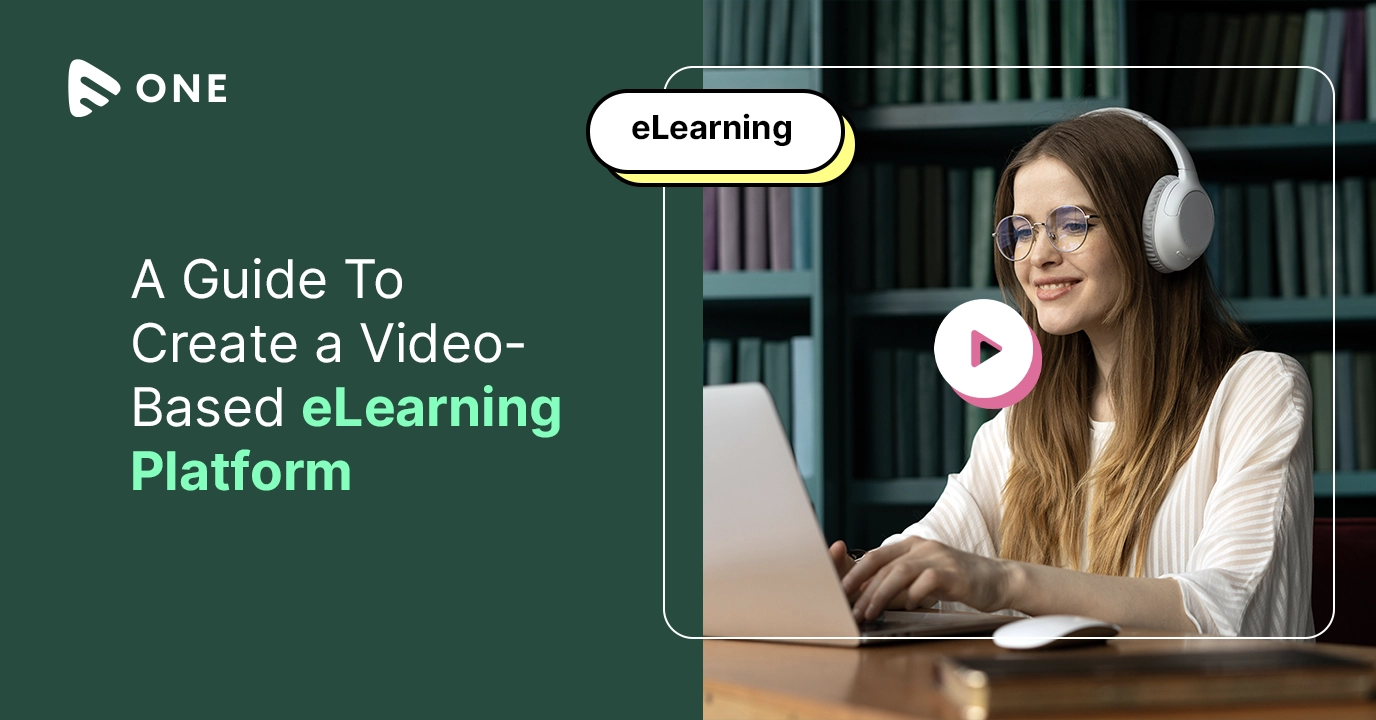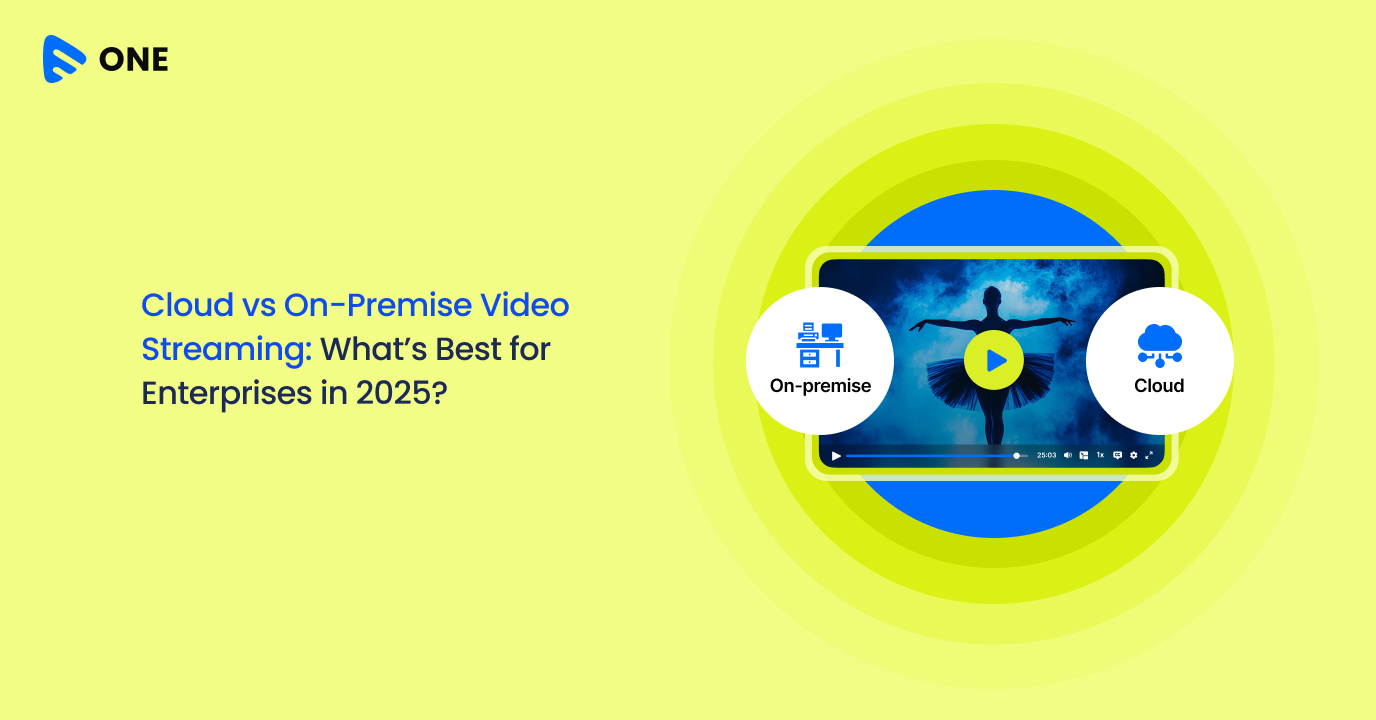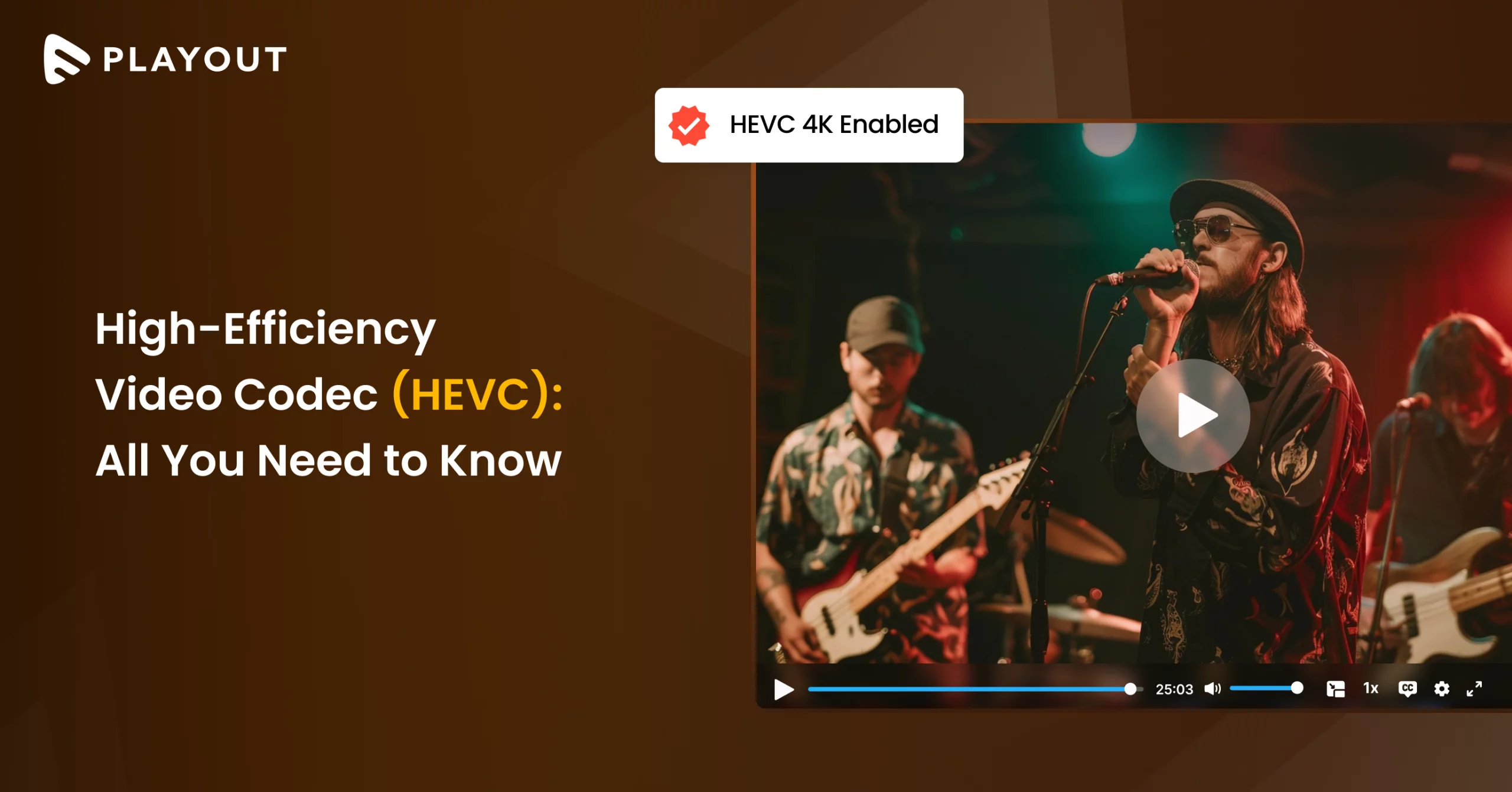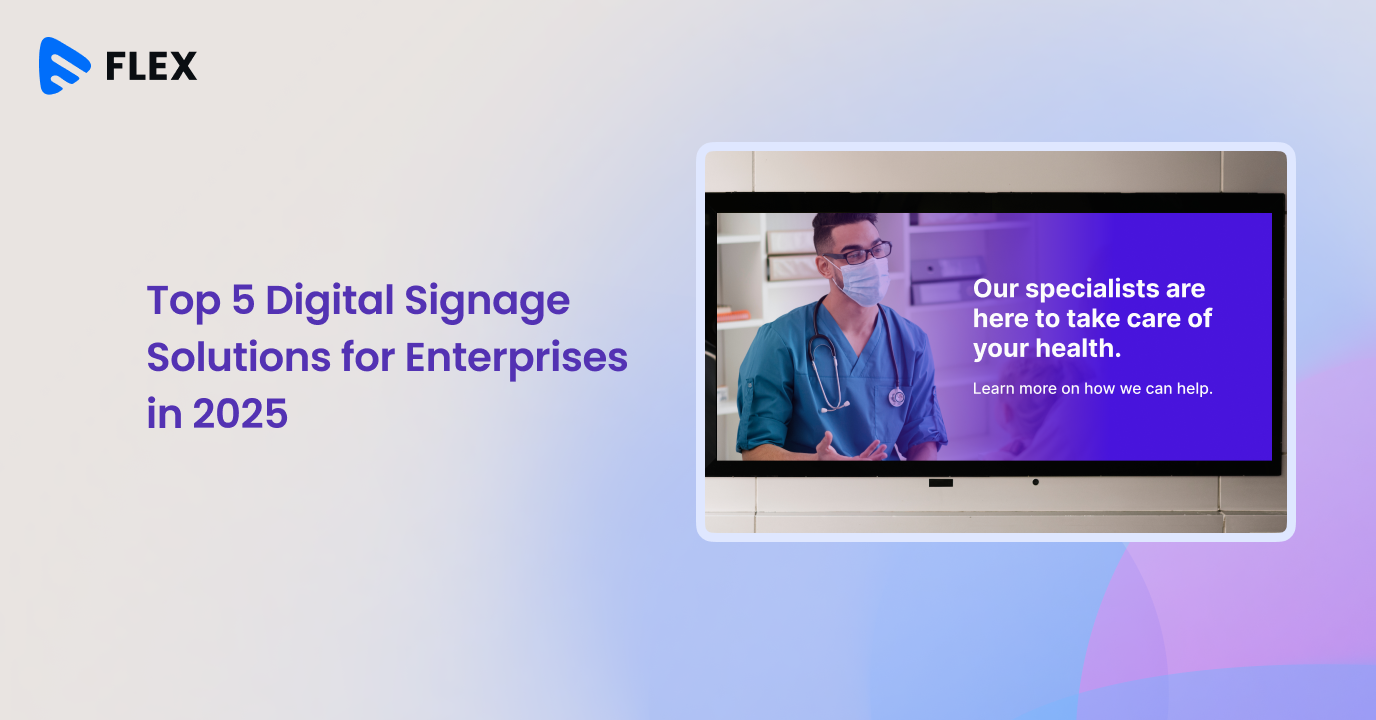Creating a video-based eLearning platform in the current educational landscape presents a compelling opportunity for profitability and impact. As stated in a recent market report, the global eLearning market was worth US $214.26 billion in 2021 and is forecast to grow at 20.5% CAGR through 2030. The demand for flexible, accessible, and engaging online learning experiences has surged in recent years, driven by technological advancements and a shift in learning preferences.
As traditional educational models evolve, learners are increasingly seeking dynamic platforms that accommodate their diverse needs. This growing demand is particularly evident in the escalating popularity of video-based content, which has proven to be a highly effective medium for knowledge retention and engagement.
With the demand for online education skyrocketing, now is an opportune moment to launch a video-based eLearning platform. And in this blog, we will guide you through how to do it easily.
What Is a Video Based eLearning Platform?
A video-based eLearning platform is a digital educational environment that leverages video content as the primary medium for delivering instructional materials and fostering learning experiences. It represents a dynamic and interactive approach to online education, where video serves as the core tool for imparting knowledge, skills, and information across various subjects and disciplines.
- A video-based eLearning platform harnesses the power of visual and auditory elements to engage learners in a way that goes beyond traditional text-based methods. Through a diverse array of video content, including lectures, tutorials, demonstrations, and simulations, learners can access educational materials in a format that closely emulates face-to-face instruction. This form of eLearning recognizes and capitalizes on the inherent appeal of visual storytelling and multimedia, aiming to create a more immersive and impactful learning experience.
- The video content within these platforms is often designed to be both informative and engaging, incorporating elements such as animations, graphics, and real-world examples to enhance comprehension and retention. Educators and content creators leverage the versatility of video to convey complex concepts, provide practical demonstrations, and facilitate a more profound understanding of the subject matter.
- Moreover, a video-based eLearning platform accommodates diverse learning styles, catering to auditory, visual, and kinesthetic learners by offering a multisensory experience. Learners can engage with the content at their own pace, rewind or replay segments for clarification, and access the material from various devices, fostering a flexible and learner-centric educational environment.
The Benefits of Creating a Video-Based eLearning Platform
1. Enhanced Learning Engagement
One of the primary advantages of a video-based eLearning platform lies in its ability to foster enhanced learning engagement. Video content, with its dynamic combination of visuals, audio, and interactive elements, captivates learners and keeps them actively involved in the educational process. Unlike traditional text-based methods, videos have the power to convey information in a compelling and memorable manner.
The visual storytelling aspect of video content is particularly effective in conveying complex concepts and making abstract ideas more tangible. Educational videos can incorporate animations, graphics, and real-world examples, providing a multi-sensory experience that appeals to different learning styles. This engagement is vital for knowledge retention, as learners are more likely to remember information presented in a visually stimulating and interactive format.
Furthermore, video-based eLearning platforms allow for the incorporation of various learning strategies, such as storytelling, case studies, and simulations, to create a more immersive educational experience. Learners can witness practical demonstrations, participate in virtual scenarios, and engage with content that goes beyond the confines of traditional lectures. This not only makes learning more enjoyable but also facilitates a deeper understanding of the subject matter.
2. Convenient Accessibility
The accessibility afforded by video-based eLearning platforms is another key benefit that contributes to their popularity. Learners today seek flexibility in their educational pursuits, and video content enables them to access materials at their own pace and convenience. Whether learners are balancing work commitments, residing in geographically distant locations, managing busy schedules, or looking for resources to help with tasks like write my essay, the on-demand nature of video-based eLearning accommodates a wide range of needs.
These platforms break down the barriers of time and space, allowing learners to engage with educational content whenever and wherever suits them best. The asynchronous nature of video-based learning means that individuals can revisit lessons, pause, rewind, or fast-forward through content to reinforce their understanding. This flexibility is particularly advantageous for working professionals, students with diverse schedules, or anyone seeking to customize their learning journey.
Moreover, the compatibility of video content with various devices – from desktop computers to smartphones and tablets – ensures that learners can seamlessly integrate their education into their daily lives. This adaptability not only meets the demands of modern learners but also promotes a democratization of education, making quality learning experiences accessible to a broader audience.
The convenience extends to the collaborative aspects of learning as well. Video-based eLearning platforms often integrate discussion forums, peer collaboration tools, and interactive assessments, fostering a sense of community among learners. Even in remote or virtual learning environments, participants can engage with each other, share insights, and collectively enhance their understanding of the material.
3. Improved Retention Rates
One of the standout advantages of a video-based eLearning platform is its proven ability to significantly enhance retention rates among learners. The combination of visual and auditory elements creates a multisensory learning experience that is inherently more memorable and impactful than traditional text-based methods.
Research consistently demonstrates that the use of video in education results in better knowledge retention. The combination of dynamic visuals, spoken explanations, and interactive elements captures the learner’s attention and promotes a deeper understanding of the material. Complex concepts become more digestible when presented through video, and learners are better equipped to recall information due to the vivid and engaging nature of the medium.
Furthermore, the flexibility inherent in video-based learning contributes to improved retention. Learners can revisit specific sections of a video, pause and reflect on key points, or replay challenging segments until they grasp the content. This adaptability allows for a personalized learning experience, catering to the varied paces and preferences of individual learners.
4. Diverse Content Options
Another compelling advantage of video-based eLearning platforms is the vast array of content options they offer. The flexibility of the video medium allows for the creation of diverse and engaging educational materials that cater to a wide range of subjects, learning styles, and educational objectives.
Educators and content creators can leverage the power of video to deliver traditional lectures, conduct practical demonstrations, facilitate virtual field trips, and even simulate complex scenarios. This diversity in content options enables a more holistic and enriched learning experience, breaking away from the monotony of conventional educational approaches.
The incorporation of storytelling into educational videos is particularly effective in creating a narrative structure that captures the viewer’s interest. Real-world examples, case studies, and interviews can be seamlessly integrated into video content, providing context and relevance to theoretical concepts. This narrative approach not only enhances engagement but also helps learners connect abstract ideas to practical applications.
Moreover, the adaptability of video content allows for the incorporation of various learning resources within a single platform. From lecture series and tutorial videos to interviews with industry experts and interactive simulations, learners have access to a diverse range of materials that cater to different learning preferences. This versatility accommodates the varied needs of a broad audience, promoting inclusivity and ensuring that educational content remains engaging and relevant.
5. Real-time Feedback
One of the distinct advantages of a video-based eLearning platform is its capacity to provide real-time feedback to learners, fostering an interactive and responsive educational environment. Unlike traditional learning methods where feedback might be delayed or generalized, video-based platforms facilitate instantaneous assessments, allowing learners to gauge their understanding and progress immediately.
Embedded quizzes, interactive elements, and instant assessments within video content enable learners to engage with the material actively. As they progress through lessons, they can receive immediate feedback on their comprehension, correct answers, and areas that may require further attention. This real-time feedback loop empowers learners to take control of their learning journey, addressing gaps in understanding promptly and reinforcing knowledge in the moment.
6. Scalable and Cost-Effective
The scalability and cost-effectiveness of video-based eLearning platforms position them as a strategic and sustainable solution for educational institutions, businesses, and independent educators alike. The digital nature of video content allows for seamless scalability, accommodating a growing number of learners without the constraints of physical infrastructure.
Educational institutions can leverage video-based eLearning platforms to reach a broader audience, transcending geographical boundaries and overcoming logistical challenges. This scalability is particularly crucial in the context of global access to education, enabling institutions to offer courses, lectures, and training programs to learners around the world.
The cost-effectiveness of video-based eLearning platforms is rooted in their ability to reduce traditional expenses associated with education delivery. Physical classrooms, printed materials, and travel expenses are significantly minimized or eliminated, resulting in substantial cost savings. This makes education more accessible and affordable, democratizing learning opportunities for individuals who may face financial or logistical barriers.
Moreover, the one-time production of high-quality video content can serve an unlimited number of learners over an extended period. Unlike traditional teaching methods that may require repeated presentations, video-based lessons remain consistent and accessible, ensuring a standardized learning experience for all participants. This efficiency not only reduces ongoing costs but also allows educators to allocate resources more strategically.
How To Create a Video-Based eLearning Platform?
1. Define Learning Objectives
The foundation of any successful eLearning platform lies in clearly defined learning objectives. Before embarking on the creation of video content, it’s essential to articulate the educational goals and outcomes you aim to achieve. Learning objectives serve as a roadmap, guiding the creation of content that aligns with the desired educational outcomes.
Start by identifying the target audience and understanding their learning needs. Consider the knowledge and skills you want learners to acquire and how these align with broader educational goals. Are you creating a platform for academic subjects, professional development, or a combination of both? Defining these objectives will inform the structure and content of your video-based eLearning platform.
Moreover, consider the level of interactivity and engagement you intend to incorporate into the learning experience. Whether it’s through quizzes, discussions, or collaborative projects, aligning learning objectives with interactive elements enhances the overall effectiveness of the platform.
2. Select Content Format
Once learning objectives are defined, the next crucial step is to select the appropriate content format for delivery. Video-based eLearning platforms offer a versatile range of formats, each catering to different learning styles and objectives. Consider the following formats to create a diverse and engaging content library:
- Lectures and Tutorials: Traditional lecture-style videos can effectively convey theoretical concepts, while tutorial videos provide step-by-step guidance for practical skills.
- Demonstrations and Simulations: Incorporate videos that demonstrate real-world applications of concepts or simulate scenarios for hands-on learning.
- Interviews and Conversations: Invite subject matter experts for interviews or facilitate virtual discussions to provide diverse perspectives and insights.
- Animations and Graphics: Use animations and graphics to simplify complex ideas, making them more accessible and engaging for learners.
- Documentaries and Case Studies: Create in-depth documentaries or analyze case studies to contextualize learning and showcase real-world applications.
- Interactive Quizzes and Assessments: Embed quizzes and assessments within videos to gauge learner understanding and reinforce key concepts.
The key is to strike a balance between different formats, ensuring that the content remains dynamic and caters to diverse learning preferences. This variety enhances the overall engagement and effectiveness of the video-based eLearning platform.
3. Choose the Best eLearning Platform
Selecting the right eLearning platform provider is a critical decision that significantly influences the success of your video-based eLearning initiative. Consider the following factors when choosing a platform provider:
- User-Friendly Interface: Opt for a platform with an intuitive and user-friendly interface. Learners should navigate effortlessly through the platform, accessing content with ease.
- Scalability: Ensure that the platform can scale according to your needs, accommodating a growing number of learners without compromising performance.
- Multimedia Support: Verify that the platform supports various multimedia elements, including high-quality video streaming, interactive features, and multimedia presentations.
- Assessment and Analytics: Look for platforms that offer robust assessment tools and analytics. The ability to track learner progress, assess engagement, and gather insights is essential for refining and optimizing the learning experience.
- Collaboration Features: If collaboration is a key component of your eLearning strategy, choose a platform that facilitates discussion forums, group projects, and interactive collaboration features.
- Customization Options: Consider the level of customization the platform allows. The ability to brand the platform, tailor the user interface, and customize features enhances the platform’s alignment with your brand and educational goals.
- Security and Compliance: Prioritize platform providers that prioritize data security and comply with relevant regulations. Ensure that the platform has robust measures in place to protect user data and privacy.
- Cost-Effectiveness: Evaluate the cost structure of different platform providers. Consider your budget and the scalability of pricing plans to ensure long-term sustainability.
- Support and Training: Assess the level of support and training offered by the platform provider. Reliable customer support and comprehensive training resources contribute to a smoother implementation and ongoing management of the platform.
- Integration Capabilities: If your eLearning platform needs to integrate with existing systems or third-party tools, ensure that the platform provider supports seamless integration.
By carefully evaluating these factors, you can choose a platform provider that aligns with your educational objectives and provides a robust infrastructure for hosting your video-based eLearning content.
4. Set Up Your eLearning Platform
The key pillar of a successful video-based eLearning platform is the creation and publishing of engaging and informative videos. The process of crafting compelling educational content involves a combination of strategic planning, effective storytelling, and high-quality production.
Muvi One, a top-notch OTT platform provider, comes with an advanced E-Learning Module that empowers you to establish a comprehensive E-Learning or training platform featuring courses, quizzes, and course completion certificates. Tailored for enterprises, corporations, educational institutions, and individual instructors, this module facilitates the creation of personalized training platforms. Through these platforms, one can seamlessly deliver online and distance learning courses along with certifications. Crafting course content is effortless, allowing the creation of recorded or live videos, audio lessons, and downloadable PDF files.
Muvi One’s E-Learning Module emerges as a versatile solution for diverse educational needs, providing a user-friendly interface for course creation, management, and assessment. The module’s flexibility accommodates both recorded and live formats, offering a spectrum of options for course content. Here are the steps to leverage it to build your eLearning platform.
To unlock the powerful E-Learning capabilities within Muvi One, follow these simple steps:
- Activation Process:
- Begin by accessing the Muvi One CMS.
- Head to “Content Management” and then navigate to “Content Settings.”
- Within the “Advanced” tab, locate and activate the “E-Learning” feature.
- Confirm your selection by clicking “Activate.”
- Free Trial Option:
- Not ready to commit? No problem.
- Enjoy a 14-day Free Trial before making any purchase decisions.
- Immediate Changes:
- Upon activation, witness an instant transformation of your website template to the sleek “Citrien” design.
- Automated Content Organization:
- Muvi One seamlessly creates a new Nested Content Group exclusively for E-Learning.
- This automated structure includes multiple levels such as “Chapters” and “Lessons.”
- E-Learning Menu Integration:
- Effortlessly locate the newly added “E-Learning” menu within the CMS menu.
Once you activate eLearning, you can easily add courses, create quizzes, and many more. Read: Getting Started With eLearning to know the detailed steps.
5. Ensure User-Friendly Interface
A user-friendly interface is paramount to the success of a video-based eLearning platform. A seamless and intuitive design enhances the overall user experience, making navigation, content access, and interaction effortless for learners. Here are essential considerations to ensure a user-friendly interface:
- Intuitive Navigation:
- Design a clear and intuitive navigation structure. Ensure that learners can easily locate courses, modules, and individual videos.
- Implement a user-friendly menu that provides quick access to essential features.
- Responsive Design:
- Ensure that the platform is responsive and compatible with various devices, including desktops, laptops, tablets, and smartphones.
- Responsive design guarantees a consistent and optimal experience across different screen sizes.
- Search and Filter Functionality:
- Include robust search and filter functionalities. Learners should be able to search for specific topics, courses, or keywords efficiently.
- Filters can help learners categorize and sort content based on relevance or preferences.
- Clear Call-to-Action :
- Use clear and concise CTAs to guide learners. Whether it’s enrolling in a course, accessing additional resources, or participating in discussions, CTAs should be easily identifiable.
- Progress Indicators:
- Implement progress indicators to keep learners informed about their advancement within a course or module.
- Progress tracking enhances motivation and provides a sense of accomplishment.
- User Profiles and Personalization:
- Allow learners to create profiles and personalize their experience. Personalized recommendations, course suggestions, and progress history contribute to a tailored learning journey.
- Accessible Content Libraries:
- Organize content in accessible libraries. Clear categorization and labeling simplify content discovery and navigation.
- Create a logical structure, with sections for courses, modules, and supplementary materials.
- Consistent Design Elements:
- Maintain consistency in design elements, such as color schemes, fonts, and icons. Consistency contributes to a cohesive and professional appearance.
- Ensure that design elements align with your brand identity.
- User Feedback Mechanism:
- Implement a feedback mechanism to gather insights from learners. This can include surveys, feedback forms, or direct communication channels.
- User feedback is invaluable for identifying areas of improvement and addressing user concerns.
- Accessibility Features:
- Prioritize accessibility by incorporating features such as alt text for images, closed captions for videos, and adjustable text sizes.
- A platform that accommodates diverse needs ensures inclusivity and a positive learning experience for all users.
By prioritizing a user-friendly interface, you create an environment where learners can focus on the content without unnecessary navigational challenges. The ease of use contributes to higher engagement and satisfaction among users.
6. Assess and Optimize
The continuous assessment and optimization of your video-based eLearning platform are essential for ensuring its effectiveness and meeting the evolving needs of learners. Regular evaluation allows you to identify areas for improvement, implement enhancements, and stay abreast of technological advancements. Here’s a guide to assessing and optimizing your eLearning platform:
- User Analytics:
- Leverage user analytics to gather insights into learner behavior. Analyze metrics such as engagement rates, completion rates, and time spent on different sections.
- Identify popular courses, modules, or videos to understand learner preferences.
- Feedback Surveys:
- Implement feedback surveys to gather input from learners. Ask about their overall experience, the effectiveness of content, and any areas they believe need improvement.
- Use both quantitative and qualitative feedback to gain a comprehensive understanding.
- Technical Performance:
- Regularly assess the technical performance of your platform. Check for loading times, video streaming quality, and overall responsiveness.
- Address any technical issues promptly to ensure a seamless user experience.
- Learning Outcomes:
- Evaluate learning outcomes by assessing learner performance in quizzes, assessments, or practical applications.
- Use learning outcomes as a measure of the platform’s effectiveness in achieving educational goals.
- Content Relevance:
- Review the relevance of your content regularly. Ensure that video content aligns with current industry standards, best practices, and the latest developments.
- Update or replace outdated content to maintain accuracy and relevance.
- Technology Updates:
- Stay informed about technological advancements and updates in eLearning technologies.
- Implement relevant updates or enhancements to incorporate new features, improve security, or enhance overall functionality.
- Accessibility Audits:
- Conduct regular accessibility audits to ensure that your platform remains inclusive and complies with accessibility standards.
- Address any issues related to accessibility features, such as closed captions or alt text.
- User Engagement Strategies:
- Evaluate the effectiveness of user engagement strategies. Assess the impact of interactive elements, collaborative features, and gamification on learner engagement.
- Adjust engagement strategies based on user feedback and performance analytics.
- Market Trends:
- Stay abreast of market trends and innovations in eLearning. Monitor industry conferences, publications, and emerging technologies that could enhance your platform.
- Consider incorporating new features or approaches that align with evolving educational trends.
- Competitor Analysis:
- Conduct periodic competitor analyses to benchmark your platform against others in the market.
- Identify areas where your platform excels and areas for improvement based on competitor offerings.
By regularly assessing and optimizing your video-based eLearning platform, you ensure its relevance, effectiveness, and alignment with the expectations of learners. This iterative process contributes to the platform’s long-term success and its ability to meet the dynamic demands of the eLearning landscape.
The Bottom Line
No doubt that video-based eLearning platforms represent the future of education, offering a dynamic and engaging approach to learning that aligns with the evolving needs of modern learners. The strategic integration of engaging videos, interactive elements, user-friendly interfaces, and continuous assessment creates an immersive and effective educational experience.
The power of visual and auditory learning provided by video content enhances information retention, making complex concepts more digestible. The current technological landscape, coupled with the increased demand for flexible and accessible learning options, makes it an opportune time to launch a video-based eLearning platform. The proliferation of high-speed internet, advancements in multimedia technologies, and the growing acceptance of online education create a favorable environment for the success of such platforms.
Launching a video-based eLearning platform now allows entrepreneurs, educators, and organizations to capitalize on the rising demand for innovative and interactive learning experiences. The ability to adapt to market trends, incorporate the latest technologies, and continually optimize the platform positions it as a strategic player in the future of eLearning.
If you are yet to make a decision, now is the time! Get started with Muvi One – take a 14-day free trial now!















Add your comment